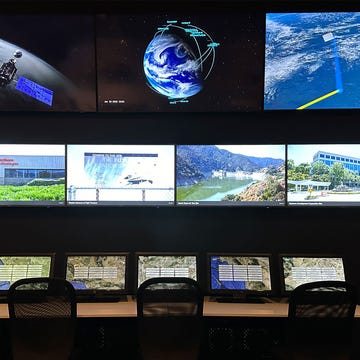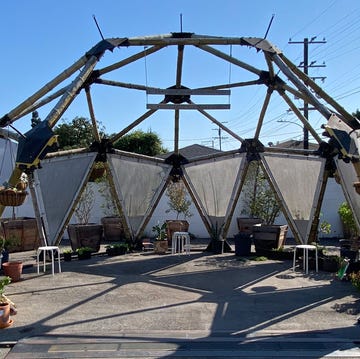Welcome to Alta Sketchbook, your guide to Getty’s PST Art: Art & Science Collide festival.
PST Art is the largest art event in the United States. Every Friday, Alta Sketchbook will offer the most intriguing takeaways from the 800-plus artists exploring the collision of art and science through exhibitions across Southern California.
Sign up for our weekly email to have our reviews and recommendations delivered straight to your inbox. And to read our previous coverage, visit Alta Sketchbook: PST Art.
Before he became a pioneering agricultural scientist, George Washington Carver was an artist. Always resourceful, Carver often made peanut- and clay-derived dyes to color his weavings and still-life paintings. To honor his creative and scientific contributions, the California African American Museum in South Los Angeles is exhibiting Carver’s rarely seen artwork as part of Getty’s PST Art: Art & Science Collide festival. Co-curated by Cameron Shaw and Yael Lipschutz, World Without End: The George Washington Carver Project puts Carver’s work in conversation with about 30 contemporary artists, including Abigail DeVille, Henry Taylor, Karon Davis, and Charles Gaines.
For instance, DeVille’s Jesup Blessup takes inspiration from Carver’s Jesup Wagon, the mobile school where he shared bulletins, plant samples, and equipment with local Black farmers. Her rendition of the 1906 wagon incorporates wood and lights. The life-size piece is mounted on a reflective base along with multicolored nebular shapes that resemble flowers.
DeVille explains that Carver had a spiritual relationship with flowers and cites her favorite quote of his: “Anything will give up its secrets if you love it enough. Not only have I found that when I talk to the little flower or to the little peanut they will give up their secrets, but I have found that when I silently commune with people they give up their secrets also—if you love them enough.”
Writer and performer Steven Vargas caught up with DeVille to discuss her connection to Carver’s art and creativity. This interview has been edited for brevity and clarity.
Steven Vargas: In the quote you just read, Carver says, “When I silently commune with people they give up their secrets.” Do you uncover secrets through your work?
Abigail DeVille: I feel very aligned with Carver’s way of thinking. Because he was an artist first, I think he looked at everything in a way that was an extension of his art practice. He says that he painted what was on the inside. I’m interested in how you can connect with material in a way that is unexpected, not informed by external sources around you.
How did you decide to incorporate the galaxy imagery into your work?
I’m super into the cosmos, things that are imperceptible to the human experience. Carver is someone who was looking to infuse new perspectives. He wondered how his way of seeing could be of service to a whole economic development of a people. Someone observed that Carver was intentional with arming Black farmers with information on how to be as autonomous from the white world as possible. The Jesup Wagon clarified some things in terms of the urgency of information distribution and not being reliant upon this racist society that’s hell-bent on destruction.
What’s one of the things that you learned about Carver that influenced either this piece or your art practice?
I didn’t realize that he wandered around as much as he did before he landed at Tuskegee [University]. His early life was totally wild. He was born enslaved, and then he was abducted, and then he was found, but then his mother was never found, and then he was raised by the people who owned him. There are so many steps that happened before he became the first Black guy to have a master’s degree in agricultural science.
This is the thing that I was talking about earlier. We all have this spark of divinity within us. How do some people tap into that, and other people never get there? I don’t know if George Washington Carver is extraordinarily brilliant or special. People talk about how heat causes impurities to leave a material. I think maybe you’re forged by the pressures of the time that you’re in, the heat of that furnace.•
WORLD WITHOUT END: THE GEORGE WASHINGTON CARVER PROJECT
Sept. 18, 2024–Mar. 2, 2025
California African American Museum
600 State Dr., Los Angeles
Steven’s Must-Sees
SENSING THE FUTURE: EXPERIMENTS IN ART AND TECHNOLOGY (E.A.T.)
Revisit two historic collaborations between art and science: 9 Evenings: Theatre and Engineering, a 1966 performance that brought together Bell Labs engineers and avant-garde artists, and the Pepsi-Cola Pavilion, an elaborate geodesic dome constructed at the 1970 world’s fair in Osaka. Through Feb. 23, Getty Center
BREATH(E): TOWARD CLIMATE AND SOCIAL JUSTICE
Conceived at the height of the global pandemic and in the wake of George Floyd’s murder, this group show features nearly 100 original works, including an immersive structure filled with live honeybees. Through Jan. 5, Hammer Museum
Upcoming Shows
SCIENTIA SEXUALIS
Oct. 5, 2024–Mar. 2, 2025, Institute of Contemporary Art, Los Angeles
COLOR IN MOTION: CHROMATIC EXPLORATIONS OF CINEMA
Oct. 6, 2024–July 13, 2025, Academy Museum
LADP PERFORMS: RESONANCE
Nov. 16–17, Barnsdall Art Park
Related Coverage
- “9 Shows to See During the Getty’s Science-Themed PST Art Festival,” ArtNews
- “George Washington Carver Was a Artist Long Before He Became a Peanut Scientist,” Forbes
Steven Vargas is an actor, a dancer, and a journalist based in Los Angeles whose work focuses on the intersections of media, social justice, and performance. He has written for the Los Angeles Times, E! News, USA Today, Dance Magazine, ARTnews, and more. He runs an independent weekly newsletter, LA Art Spot.



















